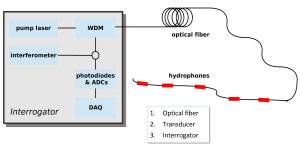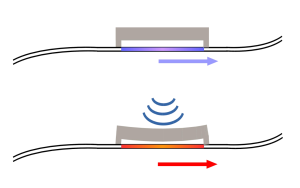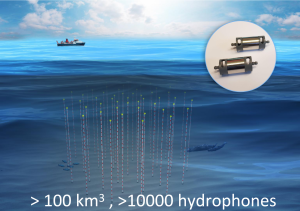From light to sound detection
The arrays of optical modules in the KM3NeT detectors register the Cherenkov light generated in the seawater by charged particles created in neutrino induced interactions with the water inside or close to the detectors.
Detection of extremely high energy neutrinos requires a different detection strategy. Since the expected flux of these neutrinos is extremely small, the instrumented volume of a detector must be much larger – more than 100 cubic kilometer. A detector volume of such a scale is only attainable by switching from light to sound detection, i.e. by switching from optical modules to hydrophones – microphones for underwater use.
Method
The energy deposition of particles induced by a neutrino interaction in the seawater locally heats up the water. Due to the temperature change the water expands or contracts thereby creating typical pressure waves that can propagate much further through the water than light.
The pressure waves can be picked up by an array of hydrophones. In the context of R&D for future larger scale neutrino detectors novel highly-sensitive hydrophones are designed based on the fibre laser technology.
With optical fibres a distributed sensing system can be established in which several hydrophones are attached to a single fibre. Advantages of this technology include low power consumption and cost-effective, relatively easy, installation of a large number of hydrophones in a large volume of seawater.
Fibre laser hydrophones
The concept of a fibre laser hydrophone relies on the measurement of a wavelength shift in an optical fiber that is induced by a pressure wave in water. The pressure wave that is generated by the neutrino induced particles deforms the fibre. A transducer that is glued onto the fibre converts the deformation into a wavelength shift. Then the wavelength shift is recorded.
The sensitivity of the hydrophone technology is determined by the performance of the transducer to efficiently convert pressure into strain in the optical fiber, but also of the optical fiber to convert strain into a wavelength shift. The optical fibre includes a fibre laser with an Erbium-doped fibre core that provides the gain of the laser light.
Marine research
This technology is not only of interest for neutrino astronomy, but it will also provide a wealth of opportunities for research across scientific disciplines. Specifically, a large hydrophone array opens new frontiers in fundamental and applied research in the marine realm. The large acoustic volume allows for underwater tracking of groups of foraging whales, and characterisation of the ocean environment, at unprecedented scales. This enables us to address fundamental questions on (the vulnerability of) severely data-deficient deep-sea ecosystems. Since detection of acoustic signals from neutrino interactions requires detailed knowledge from marine related sciences, progress in the various fields go hand in hand.
Details
Expert details about the development of the hydrophones at https://arxiv.org/abs/2501.12999v1






